The lagotto is an ancient Italin breed, the oldest of the waterdogs. It has been known since the 16th century in Italy where it was used as a retriever. The hunters sailed out from small boats with the lagottos on board and when they had shot the ducks the lagottos swam to fetch them. This is also why the breed has the typical waterdog coat, thick and curly as a protection against the water. It looks as if the lagotto was already at that time used to find truffles in the months of the year where there was no hunting.
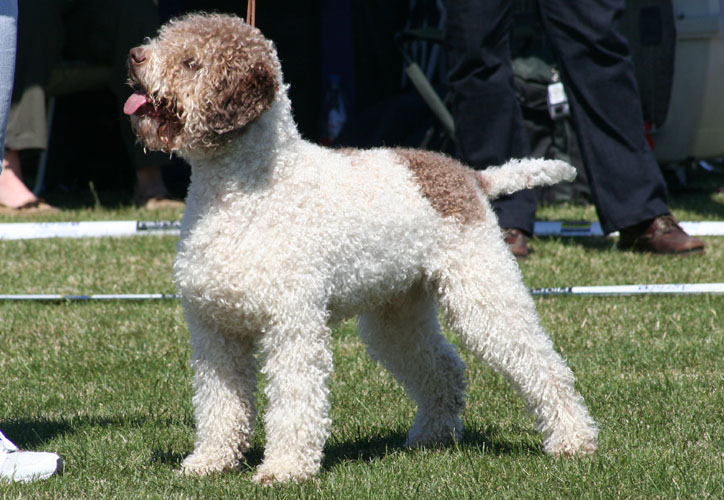
In the second part of the last century all the marshland around Rome was drained so there was no water left and no ducks either. Therefore the lagotto was trained more intensively in finding truffles. All hunting instincts were eliminated through breeding and the lagotto ended up as we know it today, as the only breed specialised in finding truffles.
Both the lagottos field of work has demanded a cooperative and obedient dog which is clearly seen today. The lagotto is very easy to work with and sticks to its owner. It is eager to please and works well as a hobby dog in nearly all kinds of dog sports. We have trained obedience, agility and tracking with our lagottos and they love it all. Furthermore most of our lagottos really love water still and they love to swim in the summer. Retrieving comes naturally and the lagotto loves to fetch and bring things to its owner and to carry things in its mouth. It is a soft dog who never needs a hard hand or a raised voice. We only need to say the things once then our lagottos understand.
They adore food which makes them easy to train. All our lagottos can walk free and come each time we call, it has actually never been something we needed to train they just stick to us by nature and don´t run far away. The breed is ideal as a family pet as it is easy to train, has a good size and is friendly to all people and animals. It is quite an active dog who loves to play though so one must be ready to spend some time with him every day. It is not a very brave dog so if you want a strong guarding dog you should find another breed. The lagotto is a soft dog and often a little careful the first times it meets new things but this does not mean it should be shy or timid. This is also a reason why sozialisation is very important when they are puppies. So look out where you buy your puppies!
The lagotto is a m edium sized dog who should be almost square. This is important in order to get the correct proportions. It should make an impression of being a light little dog with a strong back and with efficient movements and a happy wagging tail. The lagotto must never seem heavy in type or lazy. The curly coat all over the body gives the breed its rustic apearance. The lagotto should never look overgroomed or artificial it should be a natural dog to look at. The head is round and covered with more coat than the body which gives the lagotto its characteristic look.
edium sized dog who should be almost square. This is important in order to get the correct proportions. It should make an impression of being a light little dog with a strong back and with efficient movements and a happy wagging tail. The lagotto must never seem heavy in type or lazy. The curly coat all over the body gives the breed its rustic apearance. The lagotto should never look overgroomed or artificial it should be a natural dog to look at. The head is round and covered with more coat than the body which gives the lagotto its characteristic look.
The lagotto is a grooming breed which meens that there is a certain amount of care of the coat to consider. The coat should be taken care of about once a month where tangles should be removed, the ears and the feet should be looked after, the coat cut and possibly the dog washed. Once a year the coat can be shaved down. The lagotto doesn´t get its real coat before it is about one-two years old. Until then the coat is more soft.
A common mistake in Scandinavia viewed from our point of view is big and heavy lagottos who are much too long in the body and therefore loose their typical looks. We are breeding for the Italian type of lagotto the one we learned to love from Italian breeders. Small, compact dogs with effeciant movements, beuatiful round heads, happily wagging tails and never a heavy impression.
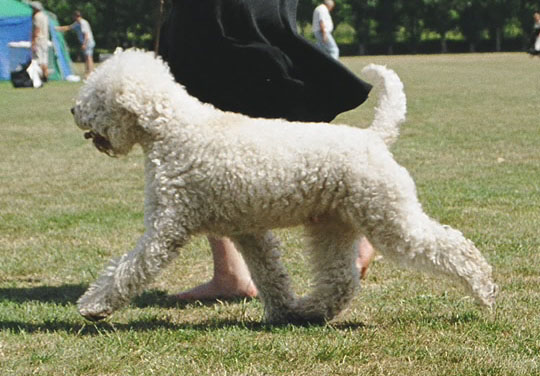
In spite of the high age of the breed it wasn´t until recently that “dogpeople” noticed the breed. Untill then the truffle men had always been breeding their dogs, but the breed was not regocnized. In 1988 the Italian lagotto club was founded and in 1991 the breed was regocnized by the Italian kennel club. Later FCI followed and in 2005 the breed received final recognition after a trial periode of ten years. As the breed is so well suited as a family pet it has already become extremely popular all over the world. Specially Scandinavia has welcomed the breed with an open heart, but nearly in all European countries the breed is growing in numbers. The lagotto can be all kinds of brown, white and orange with or without spots. It can never be black.
Our work for the breed
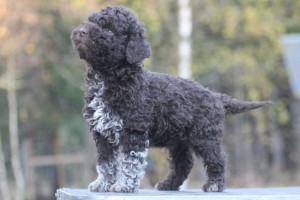 We saw the first lagotto in 1997. We fell completely head over heels for the breed and started investigating further. We were disappointed when we found out that the breed didn´t excist at all in Denmark. When we learned more we found out that the breed was actually very young and had only come to Scandinavia few years before. We thought long and hard if we dared to start with a new breed like this and decided that we did. We found the breed so extremely charming that we wanted other people to get to know it as well. Besides we already had a big experience with dogs and breeding from our other breed which should benefit us. After long studies we found where we wanted to buy our puppy and in 1999 he was born in Italy. We chose to start with a male as we first wanted to to get to know the breed before we decided if we wanted to start breeding.
We saw the first lagotto in 1997. We fell completely head over heels for the breed and started investigating further. We were disappointed when we found out that the breed didn´t excist at all in Denmark. When we learned more we found out that the breed was actually very young and had only come to Scandinavia few years before. We thought long and hard if we dared to start with a new breed like this and decided that we did. We found the breed so extremely charming that we wanted other people to get to know it as well. Besides we already had a big experience with dogs and breeding from our other breed which should benefit us. After long studies we found where we wanted to buy our puppy and in 1999 he was born in Italy. We chose to start with a male as we first wanted to to get to know the breed before we decided if we wanted to start breeding.
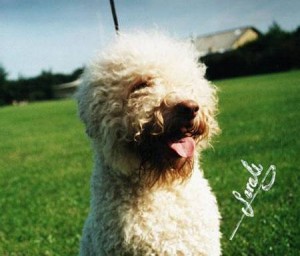
So in the autumn 1999 the breed made history in Denmark when we imported the first lagotto ever, Cry Out Italien Style. We called him Tumnus. This little gentleman came into our lives and made us all love him. All our doubts were swept away and since then the lagotto has had a big place in our hearts. It turned out that Tumnus was not only a good advertisment for the breed at home with us, he also did the breed honour by being of a very high quality.
At his very first show, the Danish kennel clubs International allbreed show in Hillerød 2000 he won best in show puppy out of more than 80 puppies of all breeds. What a debut for him and for the breed in Denmark. Since then he didn´t look back. He became the first champion in Denmark and won best of breed at nearly all shows and got many grouplplacements. Easy enough one can think as he was the only one in the country but there was actually competition from Sweden or other countries at nearly each show by well winning dogs.
When we were now sure the breed was something for us we decided to import a bitch from Italy. In the early spring 2001 I went to Italy and came home with Marina who we called Rina. Unfortunally it turned out when Rina was only 5 months old that she had a very bad knee problem. We therefore decided to spay her and never used her for breeding. In stead we bought a new bitch, this time co-owned with some of our good friends. Amira was a lovely little brown lagotto. And now they were 3 lagottos in Denmark. Unfortunately Amira had C on one hip when she was tested and we therefore chose not to use her for breeding either. Especially when it was such a new breed it was very important to us to start the breeding in Denmark with the best possible material. We had contact with several famous breeders in Italy and tried to find the perfect lines. It became clear to us that it was easy to buy a lot of dogs from Italy, but it was difficult to get to buy something really good. Therefore we were and still are grateful to the great contacts we made with serious breeders who helped us and provided us with good dogs.
In the year 2002 we were offered to buy Matisse. Matisse was one of the most winning lagottos ever in Italy, she was an Italian champion, Europewinner etc. She had good hips and already produced a litter in Italy. So we knew with what she could contribute to the Danish breeding. We didn´t have to think for one second, we said yes at once and this we never regret. To get as much genetic variation in Denmark as possible we chose to mate Matisse in Italy before we took her to Denmark with a lovely male we had seen there. The result of this was 7 beautiful puppies born in the summer 2002, the Lapinlumon A litter. Now the first lagotto litter ever in Denmark was born and with Matisse and the 3 we had already there were now 11 lagottos in Denmark. This first litter later turned out to live up to their famous parents. The male puppy we chose to keep, Lapinlumon Adamante, was only one year old when he in the summer 2003 as the first Danish lagotto ever won group 8 at a kennel club all breed show! Furthermore he became the first Danish bred lagotto who ever became Danish champion. Last, but not at all least he won the first CACIB which was ever given to lagotto in Denmark in 2005 after the breeds final regocnition from the FCI. His halfsister Lapinlumon Cassiopeia won the bitch CACIB so both of them went to Lapinlumon dogs and both of them puppies from Matisse. Other puppies from the A litter also went on to be famous out in the world.
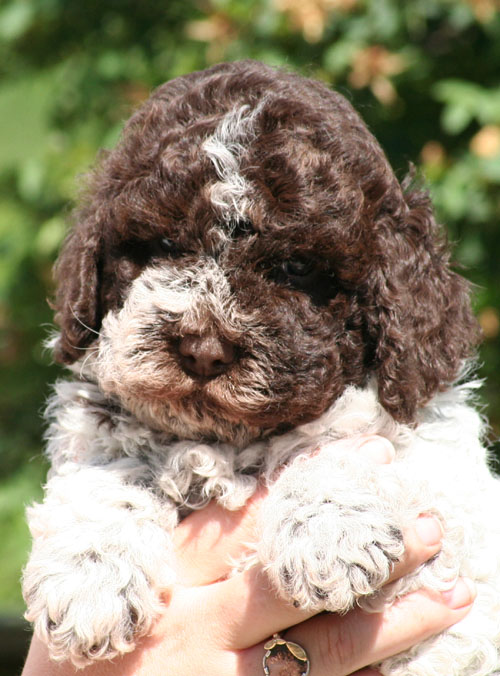 To get more lines in Denmark we bought one more adult bitch from Italy, Ruth. Ruth was of completely different lines than the dogs we had in Denmark and she too had healthy hips and already had one litter in Italy so we knew what she could produce. We had to chose between several males to mate Ruth with and chose Caio. Caio was at that time already eight years old, but he was from one of the most famous lines of lagotto in Italy as his father was the famous Pepe. Caio was himself a good truffle dog and it was important to us to get dogs to Denmark with the breeds original abilities. Besides this he had several CACs from shows in Italy and had A-hips and when we saw his offspring in Italy we truly believed he would contribute with the type and mentality we wanted. We succeeded in making Caios owner agree to let him come to Denmark with us and when Ruth had her season we mated them. The result of this was 6 nice puppies in the spring 2003. With Ruth and Caio the number of lagottos in Denmark was now 19. In the summer 2003 Matisse had her second litter for us with Tumnus as the father.
To get more lines in Denmark we bought one more adult bitch from Italy, Ruth. Ruth was of completely different lines than the dogs we had in Denmark and she too had healthy hips and already had one litter in Italy so we knew what she could produce. We had to chose between several males to mate Ruth with and chose Caio. Caio was at that time already eight years old, but he was from one of the most famous lines of lagotto in Italy as his father was the famous Pepe. Caio was himself a good truffle dog and it was important to us to get dogs to Denmark with the breeds original abilities. Besides this he had several CACs from shows in Italy and had A-hips and when we saw his offspring in Italy we truly believed he would contribute with the type and mentality we wanted. We succeeded in making Caios owner agree to let him come to Denmark with us and when Ruth had her season we mated them. The result of this was 6 nice puppies in the spring 2003. With Ruth and Caio the number of lagottos in Denmark was now 19. In the summer 2003 Matisse had her second litter for us with Tumnus as the father.
Our big work for the breed now started to work and other people started to notice the breed. A couple of dogs were imported by others from Sweden and Italy and in 2004 two new breeders started with the breed after we had been working alone with it for five years. We are happy and proud that it was us who introduced the breed in Denmark and most of all that we did it with such a good result. We put a lot of work and a lot of time in doing the best from the start and now we get the reward. Our breeding is among the most winning in Scandinavia and are without doubts the most winning lagottos in Denmark ever. Since we introduced the breed in Denmark we have won all big things there was to win. As already mentioned the first Danish champion, the first Danish bred champion, the first group winner, the first CACIB both for the bitch and male etc. even if the competition grew stronger and stronger every year. Our lagottos have been the Danish kennel club breed winner every year since the title was given the first time! From our breeding so far lots of dogs have won CACs at shows and many of them won much more and several Lapinlumon lagottos have been topwinners in different countries. This must be said to be well done.
Most importantly to us all dogs have had a nice temperament and win over fanciers of the breed where they go. They have been healthy and that too has been very important to us, to start out being restrictive and only breeding what we believed would produce healthy and happy dogs. The big work we started does not end here. We are looking forward to more years where we will work to continue what we already started and try to improve our breeding even more.
